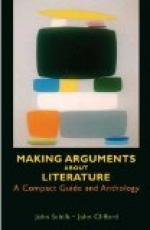Since the argument written out is the final test of the thinking, some care must be taken that students do not obscure by careless paragraphing and slovenly sentences such clearness of thought as they have attained in their brief. I have found it useful to prescribe marginal titles to the paragraphs: a student who has struggled to find a single phrase that will cover all of a sprawling paragraph will have learned some respect for firmness of paragraphing. In general, an instructor has a right to insist that his class shall apply in practice all that they have learned about the ordinary devices for getting clearness and emphasis.
In the third place, this practice in writing arguments ought to leave with students a more developed idea of how to make readers look favorably on a proposition which they are urging. I have insisted, at the risk of seeming repetitious, on the need of considering the audience whose minds are to be won over; for what persuasiveness can mean apart from specific persons to persuade I cannot conceive. Much of the perfunctory emptiness of the textbooks when they get to this part of the subject comes from neglecting this very practical and obvious side of making an argument. The difficulty it raises for arguments written in class work is just as obvious; more than most kinds of composition written for practice, arguments run the risk of having no touch with reality. Something may be done, however, if an instructor guides his class toward the kind of questions I have suggested above: an argument on the rules of football would be addressed to the Rules Committee, and most youths would know something of the prepossessions of so famous a man as Mr. Camp; an argument on a college question would be addressed to the faculty or the president, and it may be assumed that students have some idea of their general attitude on such matters. I have followed the practice in my own sections of freshmen of requiring them to put at the head of their brief and of their argument the audience which they had in mind. Then when one comes to criticism and conference one can by a little cross-examination bring home to them the very practical nature of this matter of persuasion.
One must be careful not to insist too strictly on the model and the scheme of work laid down here, and in practically the same form in other books. It is the best that has yet been devised, but any student who is set to making a brief of one of the examples of argument at the end of this book will see for himself that there is no one infallible way of making an argument. Each argument must adapt itself to its occasion and its audience; and an instructor will be wise to keep himself awake to this truth by noting divergencies from the model. The rules which are here set forth and the model which is built on them are serviceable just so long as they are serviceable, and no longer. Their chief service is done when they have set up in the minds of students a standard of effectiveness in singling out and emphasizing the critical issues of a question.




